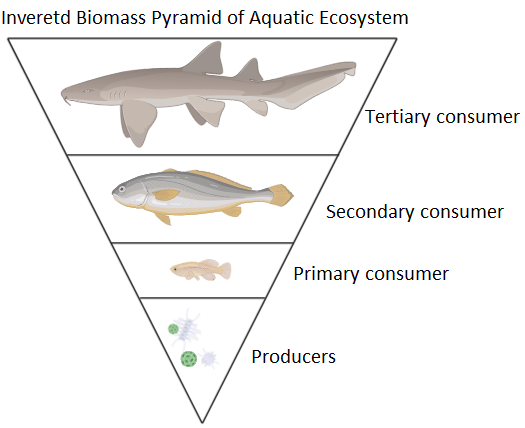
Assertion: Pyramids of biomass are inverted in the aquatic ecosystem.
Reason: Longevity increases with rise in trophic levels.
A. Both Assertion and Reason are correct and Reason is the correct explanation for Assertion
B. Both Assertion and Reason are correct but Reason is not the correct explanation for Assertion
C. Assertion is correct but Reason is incorrect
D. Both Assertion and Reason are incorrect
Answer
549.9k+ views
Hint: A pyramid of biomass is the representation of the amount of organic matter present at a particular trophic level. The volume of organic matter present in an ecosystem can be estimated using the pyramid of biomass. Longevity can be defined as the lifespan of a particular organism placed in a specific trophic level of the ecological pyramid.
Complete answer: An aquatic ecosystem consists of negligible biomass of phytoplankton on which crustaceans and small fish feed. These consumers are again outnumbered in biomass by large consumers. The large fishes have more biomass than the smaller ones.

A biomass pyramid emphasizes the quantification of the mass of organisms lying at different trophic levels. Thus, based on quantitative relationships, a biomass pyramid established hierarchies based on the organism’s mass (dry weight). Ponds or water ecosystems usually show inverted pyramids. This is because the producers that lie at the base of the biomass pyramid are small in number as stated above. The value of biomass increases on reaching the apex of the pyramid. This gives the pyramid an inverted shape. The tertiary consumers being the heaviest lies at top of the pyramid.
The longevity, on the other hand, does not relate to the rise in trophic levels. The longevity or life span of each organism is different. For example, a parrot has a longer life span as compared to humans.
Hence, we can conclude that the Assertion is correctly stated but the Reason is incorrect.
Therefore, option (C) is the correct answer.
Note: The producer in an ecosystem always lies at the base of the pyramid. The successive levels are taken by primary consumers, then secondary consumers, and at last by tertiary consumers. The tertiary consumers mark the close of the food chain. Biomass pyramids are useful in representing the amount of biomass that is present in a given food chain.
Complete answer: An aquatic ecosystem consists of negligible biomass of phytoplankton on which crustaceans and small fish feed. These consumers are again outnumbered in biomass by large consumers. The large fishes have more biomass than the smaller ones.

A biomass pyramid emphasizes the quantification of the mass of organisms lying at different trophic levels. Thus, based on quantitative relationships, a biomass pyramid established hierarchies based on the organism’s mass (dry weight). Ponds or water ecosystems usually show inverted pyramids. This is because the producers that lie at the base of the biomass pyramid are small in number as stated above. The value of biomass increases on reaching the apex of the pyramid. This gives the pyramid an inverted shape. The tertiary consumers being the heaviest lies at top of the pyramid.
The longevity, on the other hand, does not relate to the rise in trophic levels. The longevity or life span of each organism is different. For example, a parrot has a longer life span as compared to humans.
Hence, we can conclude that the Assertion is correctly stated but the Reason is incorrect.
Therefore, option (C) is the correct answer.
Note: The producer in an ecosystem always lies at the base of the pyramid. The successive levels are taken by primary consumers, then secondary consumers, and at last by tertiary consumers. The tertiary consumers mark the close of the food chain. Biomass pyramids are useful in representing the amount of biomass that is present in a given food chain.
Recently Updated Pages
A man running at a speed 5 ms is viewed in the side class 12 physics CBSE

State and explain Hardy Weinbergs Principle class 12 biology CBSE

Which of the following statements is wrong a Amnion class 12 biology CBSE

Two Planoconcave lenses 1 and 2 of glass of refractive class 12 physics CBSE

The compound 2 methyl 2 butene on reaction with NaIO4 class 12 chemistry CBSE

Bacterial cell wall is made up of A Cellulose B Hemicellulose class 12 biology CBSE

Trending doubts
What are the major means of transport Explain each class 12 social science CBSE

Which are the Top 10 Largest Countries of the World?

Draw a labelled sketch of the human eye class 12 physics CBSE

Explain sex determination in humans with line diag class 12 biology CBSE

The pH of the pancreatic juice is A 64 B 86 C 120 D class 12 biology CBSE

Give 10 examples of unisexual and bisexual flowers




